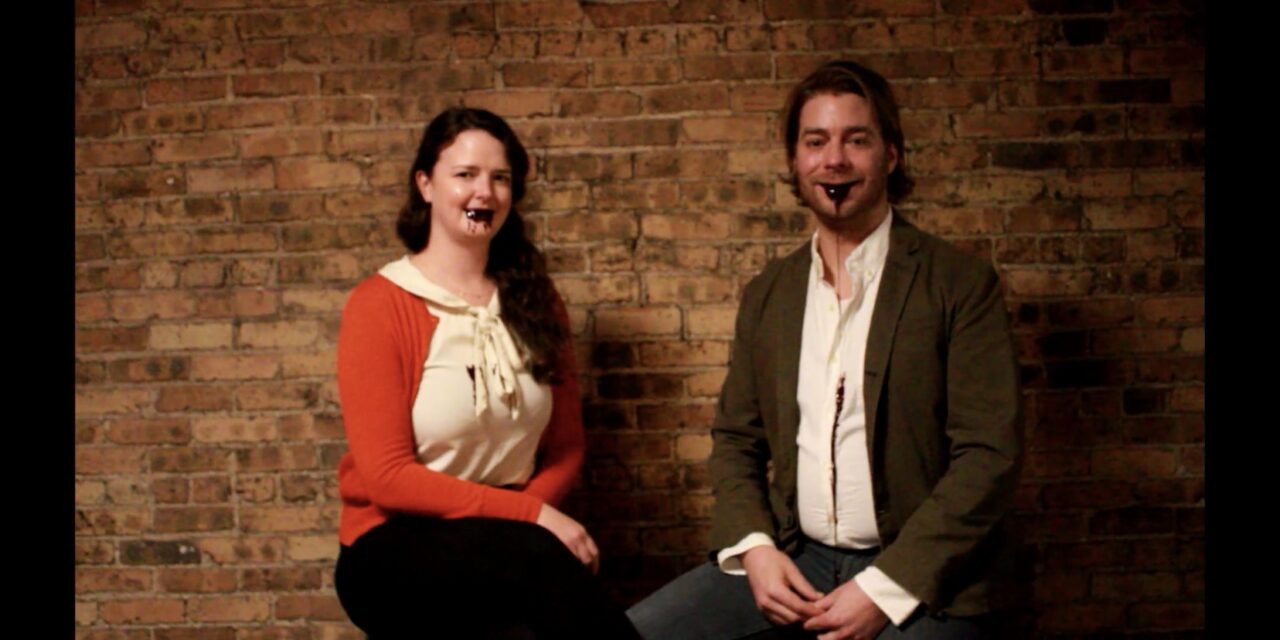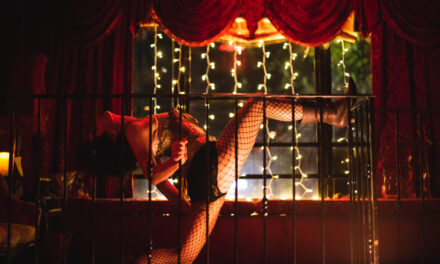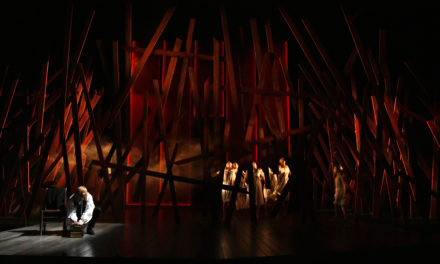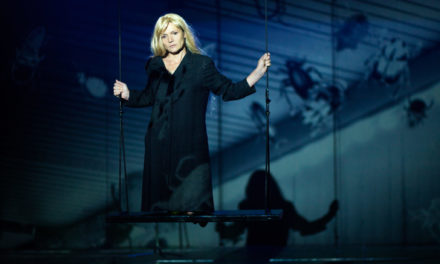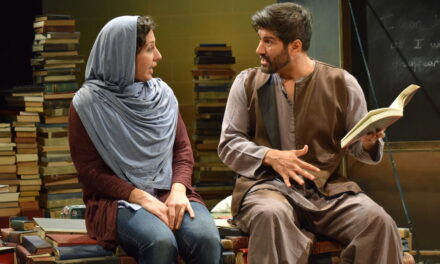While theaters around the United States typically produce The Rocky Horror Picture Show around Halloween, the city of Chicago, Illinois has a different tradition. Starting in 1987, The Annoyance Theater has produced Splatter Theater. Parodying 80s slasher movies like Halloween and Friday the 13th, the show depicts a group of stock characters who throw a party, and gradually get dispatched one by one by a masked killer. Equal parts hilarious and grotesque, the show contains inventive death scenes and even more inventive practical effects. Fake blood douses the cast members, who always wear white, as well as the audience members sitting in the front row, who sometimes wear ponchos. Truly, the show lives up to its name.
The show originated when Mick Napier and Eric Waddell were having dinner one night, when they came up with the idea for a live spoof of popular slasher films. With just a month before Halloween season, they asked themselves, could they put the show up in time? They accepted the challenge, and they did the show. Flash forward 33 years later, when a similar question came up a month before Halloween. With theaters closed due to the pandemic, could The Annoyance put the show up in a month, in a different format? Tom Troup came up with the idea of changing it to an hour long virtual performance, with Mick Napier suggesting that this time they set the show in 2020. Joe McDaniel and Cassidy Russell signed on to direct, and traded quarantine in Michigan for quarantine back in Chicago.
In updating the show for 2020 and putting it online, the directors had to make a few changes to the story (“No deaths!” Joe joked). But updates are nothing new, as the scripted show has always incorporated improvisation and changes with the cast. In fact, Joe mentioned the production would even change slightly from night to night. The online aspect of the show allowed the directors to draw from outside the local community for casting. Eric Waddell, who starred in the original 1987 production, returns to the show. Ben Zook and Joe Dietl of comedy-mystery web series Where the Bears Are cameo as The Neighbors. In order to break up the monotony of staring at performers on a screen, this version of the show features fake commercials, including a stop motion one created by Jackie Frole, and an opening music video by JC Brooks of The JC Brooks Band and Adam LeBlanc of the band Sixteen Candles.
But at the end of the day, there will be blood. The directors assured me that even with some updates, it’ll still be the Splatter Theater that Chicago knows and loves, except now they’ll get to share it with the rest of the world. They found the rehearsal process empowering for them and the performers, as they collaborated against the odds to put it together. Every household received masks (the horror kind, of course) and got ready to get gory.
Directors Joe McDaniel and Cassidy Russell took a break from their online rehearsals to talk to me a bit about the show, with the two of them speaking to me over Zoom from The Annoyance itself. “What you’re seeing right now is the most people who have been in this theater since March,” Cassidy said, referring to herself and Joe. The two of them explained how they managed to preserve a Chicago comedy tradition, update the show for 2020 and virtual space, and reimagine an iconic death scene:
This interview has been edited for length and clarity, but not for mentions of blood and gore. If either of those make you squeamish, you may wish to stop reading now.
Splatter Theater has been going on for over 30 years, and has become a Chicago tradition. What are your backgrounds with the show?
Joe: I directed it in 2018. That first year I directed, I was having just massive bits of anxiety because everybody who has seen it before was like, “are you gonna do this thing exactly like this?”
Cassidy: And they were very specific!
Joe: My instinct as a director is always to come in and try and change things up and do it my way. And so I’ll be like, “nope, we’re not gonna do that. We’re gonna try and do something new,” and people [in the crew] will be like, “oh, they’re gonna hate it,” but it all worked out fine (laughs).
Cassidy: So Joe directed the show two years ago and I was in it. And then last year, Joe wrote, and we directed a sequel to Splatter. So Splatter happened and then Joe’s show was I Know What You Did Last Splatter that took place seven years after. So that last year, people were able to at eight o’clock see Splatter, and then at ten o’clock see I Know What You Did Last Splatter.
So then this year, how did you make the transition to an online version of Splatter Theater?”
Cassidy: So the show acknowledges that the cast members are on Zoom. Because normally, there’s a scene that would be a big party, and in our show, it’s a Zoom party, because we were like, “We’re not going to try to merge their screens and have them pretend or something.” We pretty quickly came to that. So some characters got cut. Some scenes got cut, because also normally it’s a two hour show with an intermission. And that seems like too much to ask people to stare at.
Joe: I know it would be for me, so we were like, “Let’s try and keep it in an hour.” So there was kind of a lot of uncertainty, stepping into it. And I must admit that I spent a lot of time going, “Alright, this could be a total disaster.” But as things tend to do, over the course of the past week or so, it’s really been coming together and I think we actually have a real, pretty solid show on our hands, that’ll also be fun. Because the ways to get those gross out moments and stuff are now very different, because you can throw blood all over the walls like you could [in prior productions] because everybody’s shooting in their own home. So trying to figure out ways to keep the things that make people want to come back to see Splatter in there has been an interesting challenge, but some stuff is, I think, even grosser than it would be in the last format.
So it seems like a lot of things worked in your favor. Were there any unique challenges with directing this show as an online production? Any other surprising benefits?
Cassidy: So obviously, in the show, there are a lot of death scenes, and normally we’d be figuring out safety, and specifically blocking each of those, but we’re not in [the performers’] space. So we don’t know what obstacles there are, [we] really had to be trusting those actors and saying, here’s what needs to happen in your death, but we need you to block it. Because there’s no way for us to do that. So then we could give tightening pointers, but we couldn’t say, “I need you to enter a bit from here,” because there’s maybe no door there. So that kind of thing ended up being fun for the actors, but we were both kind of stressed about it before.
Joe: And there were pros and cons to that because I definitely, as a director, can hardly ever sit still. I tend to be moving around, I’m on stage with the actors all the time. And so being stuck in front of a computer was challenging. But with what Cassie was just talking about, one benefit of it was this has been a much more collaborative process than what is usually the standard for any of my shows that I’ve done. I tend to be a pretty self-admittedly controlling director (laughs).
Cassidy: You can’t be over Zoom!
Joe: You really can’t, which means that like, there’s such an even distribution of the way that ideas have been coming in for this. And it’s been, honestly, one of the most evenly collaborative processes that I think I’ve ever done.
Cassidy: A couple days ago, one of the actors said, “I have a really good idea for how I think we could make this funnier,” and sent us what he was thinking. And we both loved it. And so [the two of us] said, “Great,” you know, like, “Let’s get one more rehearsal in for that scene and see what we can use,” which normally, if I was directing a show, if one week before it opened, an actor was like, “I want to change a scene,” I’d be like, “I hate you! (laughs) How dare you! I’m tired!” But instead we were both excited, because what it means is, everybody just has to hop on their video for 45 minutes, and we can tighten up two scenes.
Without spoiling anything, were there any death scenes from the original show that made you think, “How are we going to do this online?”
Joe: I think I can say this without spoiling anything, because there’s a moment that we thought was going to work that we had to cut from the show because it would have been impossible in this situation. In the original version of the show, when the dad dies, the killer crams a pumpkin down over his head. Do you remember that one? With the egg beater?
Oh, yeah. Brains came out the top of the pumpkin.
Joe: So that prop, which has been with the theater for years and years, and is also like, pretty fragile at this point, would have had to go all the way out to California.
Cassidy: We were like, “Oh, God, I don’t want to send a pumpkin across the country.”
Joe: And so we kind of thought that that would be a moment that would be totally lost. But with the artist who does stop motion, Jackie Frole, she’s been able to take that moment and then plug that into her commercial segment. So it’s not like it’s happening in the story, but at least we can kind of “tip the cap” to stuff like that, that’s happened before that maybe we can’t do in this virtual setting.
You mentioned that the actors douse themselves and their homes with blood. How did that go over in pitching it to them?
Joe: There were varying levels of reservation about it… that often correlated to how nice the place was that somebody was living in.
Cassidy: I will say, I think we both feel so lucky with what our actors have been willing to do for this. And we’ve tried to be like, “If you don’t want to get blood on anything but your shirt, we will figure out a way to get blood on nothing but your shirt.” Then we’ve had a couple people be like, “What if I spray blood on this wall!?” And we’re like, “Okay, yeah, if you’re willing to repaint your wall!”
Joe: Overall, I’ve been pleasantly surprised by how game all the actors have been to do it. Because I’ve said for years, this is a show that I love directing. And I would never want to be in it. Because it’s so gross.
Cassidy: It is gross. The fact that people are willing to do that in their homes, I think, speaks a lot to this show, and also that people care about this theater.
So I know usually there’s a person who’s the Blood Master. Did you have one this time, and if so, how did they do their work?
Joe: Yeah, it’s Sam Locke, who has been involved with the theater for 15 years, at least. He’s been the Blood Master for this show more times than probably we could count. And so he, at the beginning of this process, basically held a Zoom workshop with the cast where he was like, “You’re gonna be doing this in your own home. But here’s how you make the blood. Here’s how you can set up a contraption to make it squirt everywhere,” and kind of just ran them through it. So he’s still technically our Blood Master for this year. It’s less hands on, but he’s definitely coached the cast through that process.
I feel like from what I’ve seen of the show and what you’ve said about the show, it seems like it always changes a little bit every year. To what extent do you feel that the show reflects the world we live in from year to year?
Joe: Yeah, I would definitely say more so this year than most, because in most years, it is kind of a callback to that 80s mentality of the way that we told stories then. And, you know, because a huge part of [Splatter Theater] is the stereotypes. So you have, if you remember when you saw it, the jock character shows up, and he’s like, “I’m a jock.” And then there’s a character who’s a slut who shows up and immediately announces herself as the slutty character.
Cassidy: So using those tropes. And so that was something we really had to figure out. Because this is so clearly set in 2020, which it never has been before. It’s always been loosely the 80s in the past. And we have no interest in making fun of what’s happening in the world right now. So this is not a show full of Coronavirus jokes. But [using tropes], I would say, is the biggest change, probably because of acknowledging this is happening now. So figuring out, like, do those characters make sense now? And if not, how do we make them make sense now?
When I saw the show a couple of years ago, some of the tropes had received updates to reflect the times. I remember the “slut” character’s gender was swapped from the original.
Cassidy: So we do have a female actor playing that role this year. And in the first rehearsal, we were like, “So you know, this character is called the slut in the script, we can do whatever-” and she was like, “Nah, I’m good with it.” And she basically was like, “I feel like I can be empowered, because I’m the one who says it. No one calls me it. I announce it about myself.” And then we’ve had moments where she was like, “That didn’t feel good.” And we’re like, “Then we won’t do that.” We love punching up, but we’re not interested in punching down.
So there are myriad ways of acknowledging anything that could be problematic, saying “Oh, okay, how do the actors want to do it? What feels right to them?”
Cassidy: That’s something I think The Annoyance does really well, in general. I normally teach improv here. And that’s something we always talk about in class, is the idea of like, you can make whatever jokes you want, but if they make someone else feel small, we’re not putting that on our stages. And that’s something that we both are very clear on as directors. And so we’re lucky that having a fair amount of diverse viewpoints in this show, we were able to have people be like, “What if I make this joke?” and it’s a joke that’s empowering to them that maybe is a joke I wouldn’t feel comfortable making. And that I think is pretty cool and fun, of getting to work with actors who have a comedic voice and are willing to push boundaries that are their boundaries to push.
Joe: And I think the environment of support within the team, and the cast too, is huge. I was reminded of that the other day in one of our zoom rehearsals. Hoja Lopez sat down and just missed her chair. Just fell off screen. It isn’t part of the show. But her response and the response of the cast was so unbelievably supportive. They laughed, but you just kind of feel the genuine camaraderie in that moment. We used it as a little promo for the show. There was never a hint of embarrassment from anybody or a hint of anything mean spirited. And I think that kind of energy will be felt in the actual production as well.
Splatter Theater is a Chicago Halloween tradition. And watching horror movies on a screen is a nationwide or worldwide tradition for Halloween. What does it mean for you to both be able to take this Chicago tradition and share it with the world?
Cassidy: This show is so dumb, but in a very silly way, matters so much. I think [for] most people who’ve ever been in it or directed there is a sense of carrying on a little bit of tradition and a little bit of [being] honored to just be a part of [it]. I mean I haven’t worked at another theater where you got to be part of a show that’s been happening for 34 years. So just being able to be a part of that in general in the Chicago community is very cool.
Joe: Hopefully it’s a motivation for people to be able to come back when things are opening back up and see what it is we do here, because The Annoyance is unique. The comedy that happens here is so goofy, so the opportunity to share that with people outside of the community is really, really exciting. Hopefully the things that are special about The Annoyance will be present in this production and will encourage people to continue to keep up with us and know what we’re about.
Any other hopes for people experiencing this online and for the future of the theater?
Joe: Hopefully the reach of the internet will allow us on a purely practical level to drum up not just emotional and artistic support, but some very real financial support for a theater that needs it. Also, even aside from our bias of loving this place, theaters all over the city and the country are all struggling. So for every one that we can keep going, whether it’s one more month or two more months or anything like that, it’s important. Because the arts are taking a hit just like everything else is, but a lot of times the art programs don’t have those kinds of backup systems that a lot of other programs might. Everybody is going to continue to have access to TV but there’s something different about having an in-person experience like [Splatter Theater] that can really affect and uplift people and in times like this people need to be lifted up.
Cassidy: And if it’s even a hundred people who watch it on Halloween night, that’s a hundred people who didn’t go maskless to a bar to party on Halloween and that also feels good to us.
Splatter Theater douses homes with blood at 9pm cst on Saturday, October 24th, Friday, October 30th, and Saturday, October 31st. As a fundraiser for The Annoyance, ticket prices are a suggested donation of $20 for the first two performances. Halloween night has a fixed price of $20 with an optional $10 add-on for a post show virtual Halloween party. Tickets are available at theannoyance.com.
This post was written by the author in their personal capacity.The opinions expressed in this article are the author’s own and do not reflect the view of The Theatre Times, their staff or collaborators.
This post was written by Andrew Agress.
The views expressed here belong to the author and do not necessarily reflect our views and opinions.

